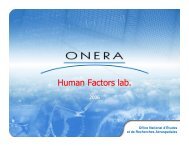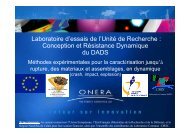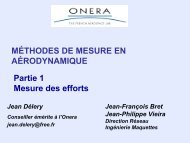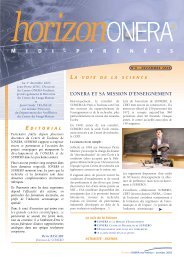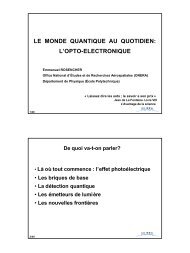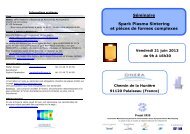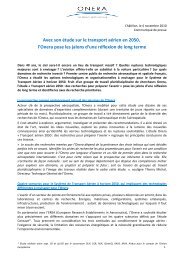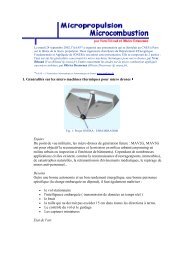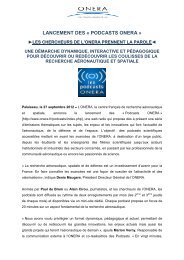From Air Transport System 2050 Vision to Planning for ... - Onera
From Air Transport System 2050 Vision to Planning for ... - Onera
From Air Transport System 2050 Vision to Planning for ... - Onera
Create successful ePaper yourself
Turn your PDF publications into a flip-book with our unique Google optimized e-Paper software.
VEHICLE CONFIGURATIONS<br />
Weight reduction: a key driver <strong>for</strong> efficiency<br />
Minimising aircraft weight is a key driver <strong>for</strong> efficient transportation, so technologies enabling this are of great interest. Within the ACARE <strong>Vision</strong> 2020<br />
programme a potential overall mass reduction of 30% has been envisaged. However, single lightweight materials will not be sufficient <strong>to</strong> achieve such a<br />
challenging goal. More integrated interdisciplinary approaches will be needed such as:<br />
• Integrated design<br />
• Materials-related design and efficient local use of lightweight materials<br />
• Production of large integrated panels<br />
• Efficient assembly<br />
Three principle directions can be derived from these opportunities:<br />
• material-oriented design methods<br />
• integration of different materials systems<br />
• adequate production <strong>to</strong>ols and procedures<br />
…in parallel with the development of new materials and integrated structures.<br />
Integrated structural design<br />
Composite materials and manufacturing technologies allow <strong>for</strong> the design of more integrated structures with fewer fasteners, reducing weight. Other advantages<br />
compared <strong>to</strong> metals include fatigue damage resistance, corrosion resistance and thermal insulation.<br />
The drawbacks of these materials are, in general, their sensitivity <strong>to</strong> impact, limited damage <strong>to</strong>lerance properties and low electrical conductance. Composites<br />
already represent up <strong>to</strong> 50% of the structural weight <strong>for</strong> the most modern commercial aircraft, such as the Boeing 787 and <strong>Air</strong>bus A350.<br />
Aeroelastic tailoring<br />
<strong>Air</strong>craft wings are designed such that their shape yields optimum lift and load distribution, but these values vary as the wing is de<strong>for</strong>med during flight. Aeroelastic<br />
tailoring can generate wing designs that deflect under loading in such a way as <strong>to</strong> moderate the internal load increase. Composites are particularly<br />
useful <strong>for</strong> this type of design because, by orienting fibres in specific directions, the stiffness characteristics of the structure can be designed <strong>to</strong> give precisely<br />
the de<strong>for</strong>mation response <strong>to</strong> the experienced loading <strong>to</strong> achieve the optimum wing shape.<br />
Self-healing materials<br />
A structurally-incorporated ability <strong>to</strong> repair damage caused by mechanical use over time. Current research on composite materials will expand the scientific<br />
understanding of self-healing materials and introduce the cradle-<strong>to</strong>-cradle concept <strong>for</strong> thermoset-based plastics and composites.<br />
Material-related structural design<br />
Life cycle assessment studies of environmental emissions have demonstrated the benefits of structural aircraft components made from lightweight CFRP<br />
in comparison <strong>to</strong> aluminium and Glass Laminate Aluminium Rein<strong>for</strong>ced Epoxy (GLARE), expressed in fuel consumption and CO2 emissions and taking in<strong>to</strong><br />
account their “cradle-<strong>to</strong>-grave” emissions.<br />
Besides increasing the amount of composites in the airframe structure, further weight and fuel burn reduction can also be achieved by further optimising<br />
current composite structures in terms of cost and per<strong>for</strong>mance.<br />
Unconventional fibre lay-ups / elastic tailoring<br />
Lighter composite structures can be obtained through improved local directional stiffness properties. This can be achieved by local elastic tailoring of structures<br />
using advanced fibre placement, in combination with advanced design, analysis and optimisation methods, including “as-manufactured” material<br />
details in the design loop.<br />
13



